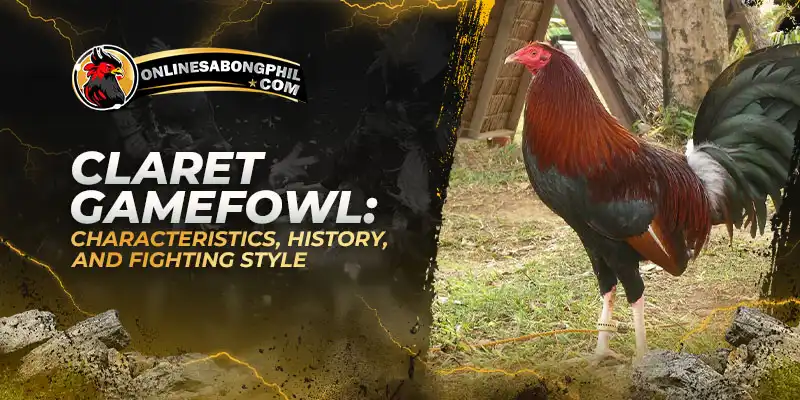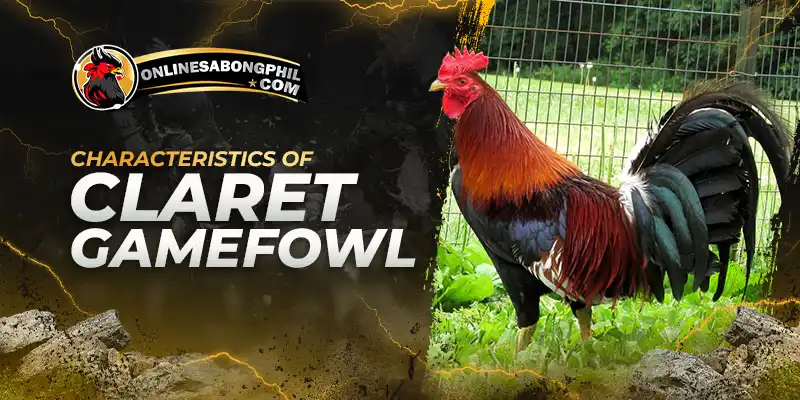Claret gamefowl are known for their intelligence, striking appearance, exceptional fighting skills, agility, power, and cutting abilities. These birds feature black breasts, wine-red coloring, and white accents. Roosters stand out with dark red plumage, pearl legs, black spurs, large heads, and white tail streamers. Clarets are known for their precise cutting, aerial attacks, and relentless fighting style.
This rare and successful bloodline is also known for its strong brooding and mothering instincts in hens.
Bloodline History
John H. Madigan unintentionally created the original Claret gamefowl. A Duyrea Whitehackle hen, placed in a racetrack yard with a Hank Dean cock, produced nine deep red stags resembling the color of claret wine – thus their name. These first Clarets quickly gained recognition as a formidable strain.
The following spring, a hen hatched a large clutch that included nine more wine-colored stags with white and yellow legs. These proved equally successful, with approximately one in every eight or ten turning out white.
Claret gamefowl are typically straight-combed, with black breasts, wine-red coloration, white-streaked wings and tails, and white legs. They are compactly built, weighing between 1.9 and 2.3 kilos. Roosters boast large heads, dark red plumage, pearl legs, and black spurs.
The Claret Combat Style
Claret gamefowl are renowned for their dynamic and aggressive fighting style, making them a spectacle in the cockpit. Here’s a deeper look at what makes them so formidable:
- Aerial Supremacy: Clarets take the fight to the skies. They launch themselves with incredible force, raining blows down on their opponents from above. This aerial prowess gives them an edge in reach and the element of surprise.
- Heel-Focused Strikes: Unlike many breeds that rely on beak holds and grappling, Clarets prioritize delivering devastating cuts with their heels. These strikes are both powerful and lightning-fast, likened to the thrusts of a skilled swordsman.
- Calculated Aggression: The Claret’s fighting style isn’t just about brute force. They possess exceptional accuracy, targeting vulnerable areas with each strike. Their calculated attacks aim to inflict maximum damage and quickly disable their opponents.
- Relentless Pressure: Clarets are known for their forward-pressing approach. They rarely back down, continuously driving their opponents with a barrage of aerial attacks and cutting strikes. This unwavering aggression can overwhelm and break down even the toughest foes.
The Claret fighting style is a testament to the breed’s speed, power, and strategic cunning. Their unique approach and devastating strikes make them a feared and respected force in the gamefowl world.
The Winning Strike
Every fight, every contest, hinges on decisive moments. Those singular actions that shift momentum change the course of the battle and ultimately lead to victory.
- Cutting Strikes with Heels: Their signature move involves delivering precise, powerful cuts with their heels. These strikes target vulnerable areas, aiming to inflict maximum damage and quickly disable their opponents. Clarets are known for their exceptional accuracy with these strikes.
- Aerial Assault: Clarets take the fight to the air, launching themselves with force and surprising opponents with strikes delivered from above. This aerial advantage gives them greater reach and the element of surprise.
- Calculated Strikes: Their attacks aren’t just about brute force. Clarets target specific areas with their strikes, aiming for maximum impact.
How these strikes contribute to winning
- Disabling Strikes: Their cutting heel strikes can inflict serious cuts and injuries, quickly disabling an opponent.
- Element of Surprise: Their aerial attacks often catch opponents off guard, making them harder to defend.
- Targeted Strategy: The calculated nature of Claret strikes destabilizes opponents and creates openings for further attacks.
Characteristics of Claret Gamefowl
The Claret gamefowl is a breed steeped in history and renowned for its distinctive qualities. From their striking appearance to their fierce fighting prowess, these birds have earned a place among the most respected gamefowl bloodlines.
Appearance
The defining feature of Clarets is their rich wine-red plumage, reminiscent of the claret wine that inspired their name. This deep red is complemented by black breasts and contrasting white streaks on their wings and tails. Some Clarets may even exhibit a slight spangling pattern within their feathers.
Power and Agility
Clarets are built for both strength and speed. Their compact and muscular bodies provide the raw power needed for explosive attacks and cutting strikes. The wide stance of their legs grants them exceptional balance and stability in the pit, allowing them to absorb blows and maintain their footing during intense battles.
Ideal Weight
The optimal weight range of 1.9 to 2.3 kilograms strikes a balance between being heavy enough to deliver powerful blows yet light enough to maintain agility and quick reflexes.
Breeding Traits
Claret hens are not only fierce fighters but also dedicated mothers. They are known for their excellent brooding skills, ensuring a high hatch rate of their eggs. Their strong mothering instincts drive them to fiercely protect and nurture their chicks.
Claret Gamefowl Strength and Weakness
The Claret gamefowl, like any fighting breed, possesses both strengths and weaknesses. Understanding these traits is crucial for breeders and those interested in their performance in the pit.
Strengths
- Cutting Ability: Clarets are renowned for their exceptional cutting power, delivering precise strikes with their heels that can inflict serious damage.
- Aerial Combat: Their ability to execute powerful aerial attacks gives them an advantage in reach and the element of surprise.
- Aggression: Clarets have a forward-pressing, relentless fighting style that can overwhelm opponents.
- Speed and Agility: Their compact build and muscular legs contribute to their quick reflexes and maneuverability in the pit.
- Intelligence: Many breeders consider Clarets to be highly intelligent fighters, capable of adapting and finding openings to exploit.
Weaknesses
- Vulnerable to Ground Fighters: Clarets excel at aerial attacks but may struggle against breeds that specialize in ground grappling or shuffling styles.
- Reliance on Cutting: Their focus on cutting strikes can be less effective against opponents with thick, protective feathers or exceptionally tough skin.
- Susceptibility to Fatigue (Potential): Some suggest that the Claret’s aggressive, high-energy fighting style might make them more prone to tiring in longer battles.
- Variability within the Bloodline: Like any breed, there can be variations in individual birds. Some Clarets may not exhibit all the typical strengths to the same degree.
Important Considerations:
Breeding and Conditioning: The strengths of the Claret can be maximized, and some weaknesses mitigated, through selective breeding and proper conditioning.
Opponent Match-ups: As with any breed, the success of a Claret is influenced by the specific opponent they face and how their styles interact.
Conclusion
The Claret gamefowl stands as a testament to the combination of raw power and calculated precision. Their exceptional cutting ability, aerial prowess, and relentless aggression make them a formidable force in the pit. This breed’s success highlights the importance of targeted strikes and an unwavering fighting spirit. Claret Gamefowl bloodline is one of the best for sabong breeds.
Visit us at Onlinesabongphil.com for more guides and tips!
Read more: https://onlinesabongphil.com/brooding-and-gamefowl-bloodline-maintenance/



